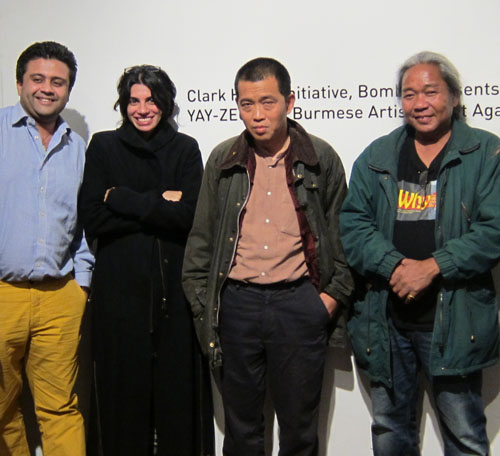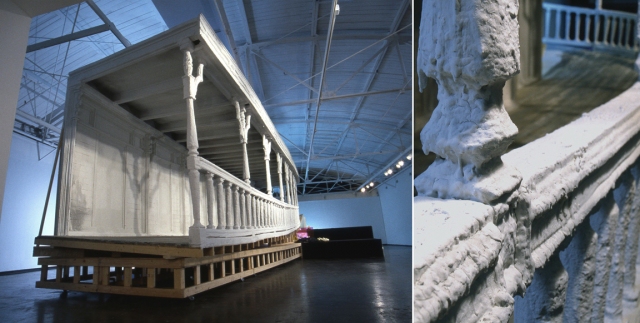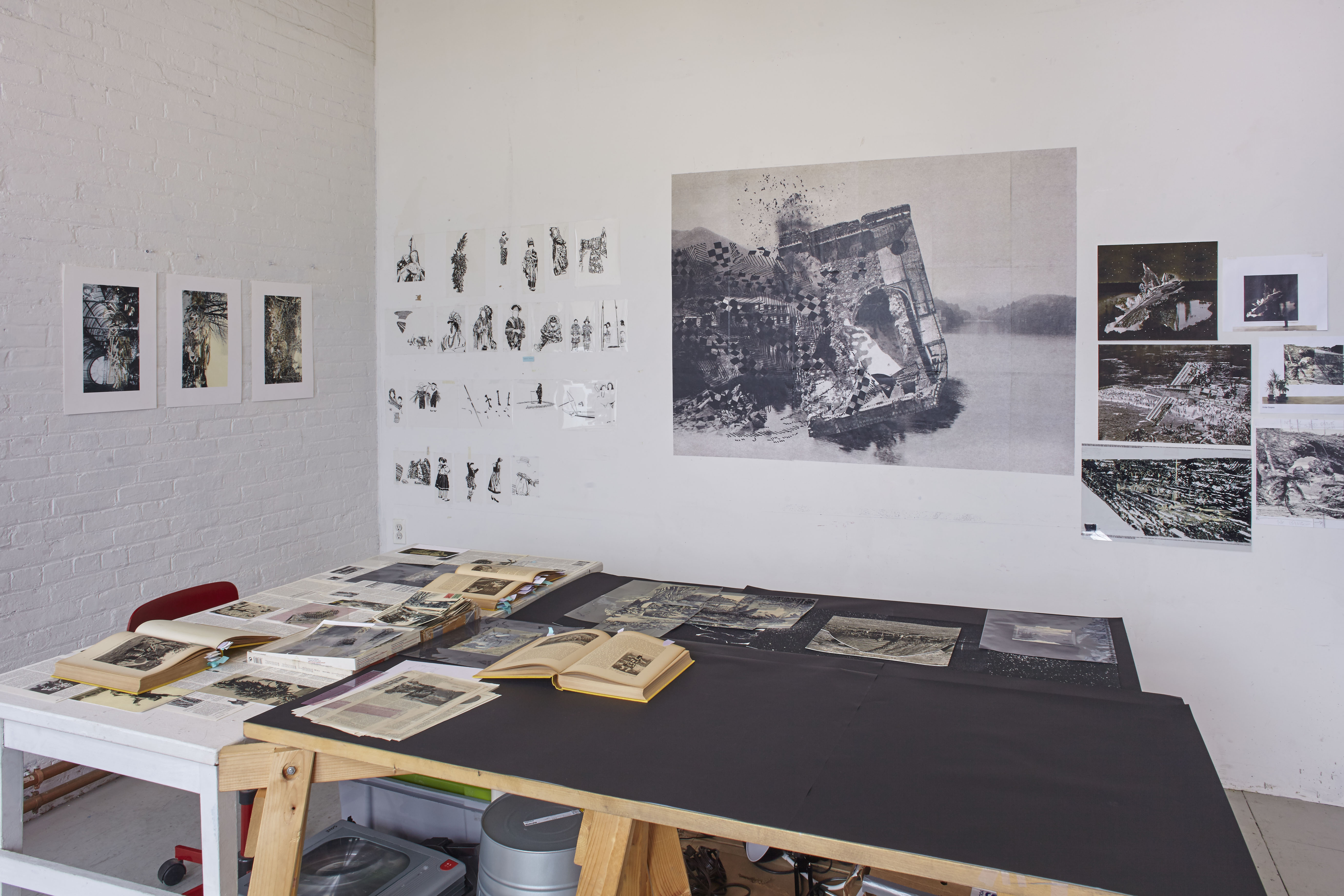In April 2016, ISCP will welcome Lugar a Dudas from Cali, Colombia for an institutional residency. Here, take a look back at ISCP’s institutional residency with Clark House Initiative, Bombay in 2012. ISCP former Program Fellow Chelsea Haines sat down with Clark House to speak about their exhibition for ISCP.
Clark House Initiative, founded by Sumesh Sharma and Zasha Cola, is a curatorial practice about a place, which in sharing a junction with two museums and a cinema, mirrors the fiction of what these spaces could be. Clark House organized the exhibition Yay-Zeq: Two Burmese Artists Meet Again at ISCP along with a series of discussions and performances that featured the two Burmese artists Htein Lin and Sitt Nyein Aye.
Chelsea Haines: I am curious to know how Clark House started. What was its intended goal and purpose?
Sumesh Sharma (SS): Clark House acts as a space in a city that often leaves few venues for a discourse on art to emerge. Since 2010, Clark House has grown symbiotically attached to the printmaking studio of the Sir JJ School of Arts, where we mentor the students through a series of workshops and invite artists to introduce them to conceptual art practice. Through the workshops we were able to publish print portfolios that were sold to garner funds for scholarships and a corpus for the activities of the students. The students often aid us in our activities by helping us out with our curatorial projects. Last year a young collective, Shunya (Zero), came into existence. It was initiated by seven young graduates from three different art schools who have been associated with Clark House either as interns, or as participants in our workshops. It is through Clark House that they, along with others young artists, meet, discuss, and research.
Secondly, we are an artist supported collaborative. We come from a lineage in initiatives such as Open Circle; its founders, Tushar Joag and Sharmila Samant, helped prop up Clark House during its initial phase and have since been our most trusted advisors. We also work on an alternate art history project through which we uncover art practices ignored by an art historical approach that is often informed by the market.
Lastly, Clark House is not about the physical space it inhabits, and we have often endeavored to open up spaces to visual art practice that hitherto had not been seen as exhibition spaces. Our project with Padmini Chettur was one such example where we worked with contemporary dance, situating the performance within the last cotton cloth-mill in the erstwhile industrial district of Bombay. Juxtaposing her project against the mechanical movement of the machines as the displacements of dance became the metaphors for the gentrification of the district that is replacing the mills and the housing colonies. We have collaborated with a make-shift temporary shrine that comes up each year during a religious festival to host a performance by a young artist Amol Patil, which took place on one of the busiest streets of downtown Bombay to circumvent police permission for this project which otherwise would have made it impossible.
What role do you see Clark House fulfilling in the Bombay art scene?
Zasha Colah (ZC): At the end of 2010, we were very impatient for a curatorial practice that would cut closer to the skin. We were so exhausted with waste of all kinds in this consumerist approach to art that did not seem to give as much as it took away. We began to cut off and make very abstract, even absurdist gestures, which was understood in its context, perhaps by more people than we could have foreseen. The climate was rather bleak and we were in the midst of a recession. So we realized that we would have to experiment with new models of economic sustenance. The warmth with which our first gestures toward a different kind of practice were greeted gave us an inkling of the kind of friendships and networks the city was equally impatient for.
We began to make photographs, drawing in the changes we wished to see in the city, and gave them metaphoric dimensions that related to political events in other parts of the world. These became theoretical curator’s notes. And till today, these notes inform how we work. We realized we wanted to do very small things, even as we planned long-term projects involving years of research. We could envision a practice that engaged public infrastructure for art, but was not restricted by it.
What do you see as some of your key projects over the past few years?
ZC: Previous projects have tended toward the political, or where a sense of anguish accompanies the history of certain places: projects to find vocabularies to theorize the mill areas of Bombay from where so many were displaced, through dance; or the exhibition Right to Dissent which took place in a labor union. Other projects intertwine content with the history of the objects inside Clark House itself, as in Arranging Chairs for Ai Weiwei. Another exhibition traced the history of the Roma in Europe to their mythical Indian origins while commenting on the rise of a fascist right-wing in Hungary. Against AFSPA, was a project of flags made by artists to protest a legislative act that protects brutality and abuse of power by the state. Other projects have pursued an alternative visual arts history, such as the exhibition reviving a pioneering Indian modernist artist AA Raiba, by recreating his studio space.
How was Clark House invited to the institutional residency at ISCP?
ZC: Kari Conte invited us to be the second institution in residence at ISCP. It is her curatorial idea, and we, from our context, could really appreciate its core premise of mutual exposure, where an institution relocates to another city to carry on its activities as usually as possible. This is exactly what we did. Our experience of collaborating with Kari and her team was a careful honing of ideas to something very precise and mutual.
Why did you decide to organize the show ‘Yay-Zeq: Two Burmese Artists Meet Again’? Did Htein Lin and Sitt Nyein Aye already express a desire to meet again or did you propose this?
ZC: We have been working on this project over the last five years. The story of their first meeting is the subject of a captivating series of drawings made by Sitt Nyein Aye, which documents their meeting in the Indian forests after the 8888 Uprising in 1988. It was in the forest camp that Sitt Nyein Aye taught Htein Lin art for two years, on two sheets of A4 paper and often drawing in the mud of the forest floor. Htein Lin expressed the desire to see his teacher again to us.
Their meeting is also the crossing of two journeys of thought at a particular juncture. For Sitt Nyein Aye, the path was one of non-violence. His icons were Aung San Suu Kyi and Gandhi. He devised a path through art and culture; to be an artist was to be political. Therefore, in his bleakest moments, he began to teach art, and won the interest and passion of Htein Lin. For Htein Lin, then a law student, his reading at the time led him to Che Guevara. He believed that a guerrilla war with the military regime was the only way forward. In a few months after leaving Sitt Nyein Aye’s company in India, he would recall his friend and revise his position, choosing an ‘Artist’s Life’ – and this for the two of them has very deep philosophical and political meaning.
Htein Lin called this convergence the dream of a Tree-Gun Revolution, for many of the students hewed guns from branches in order to train, dreaming each night, that one day they would have guns to fight the military. Htein Lin has now made cultural resistance his own, but I was interested in his path towards it. It brings in Brechtian questions of violence and I was keen to formulate this crossing of philosophical, contemplative journeys, in the form of an exhibition, and ultimately, a public conversation between these two artists, which we recorded, and which to me, is quite historic.
Many of the works shown or performed in the exhibition are quite emotionally and politically intense. What was your interest in reflecting on the Burmese political situation in New York? What was your intended reaction from the audience?
ZC: These intense works, to me, are a survival kit for dealing with extreme political egress, but we realized early on, that this is also the human condition, and that each one of us needs these cultural, mental tools.
SS: Within the south Asian region India is often seen as an insensitive neighbor that is indifferent to the geopolitical realities that their surrounding countries face. Over the last decades India has been supporting the Military Junta in Burma, so much so that during her recent to visit India Aung San Suu Kyi rebuked it for abandoning the legitimate struggle of the Burmese people for democratic freedoms.
The exhibition often faced logistical challenges in terms of visas that were not granted to the artists and a general lack of support. Through funding from FfAI (Foundation for Arts Initiatives) in New York and the ISCP residency we were able to produce the project in New York where Sitt Nyein Aye and Htein Lin finally reconnected. We were welcomed by a large community of Burmese political exiles in New York and the show itself saw responses from a large and diverse audience.
The exhibition has now traveled to the Kochi-Muziris biennial. Can you explain a little what the biennial is and how the exhibition may have changed as it traveled there?
SS: The exhibition in Kochi is situated at Mandalay Hall, a 17th century colonial structure once home to a Jewish family that traded with Mandalay, the imperial capital of Burma and the hometown of Sitt Nyein Aye. The idea of refuge characterizes the city of Kochi as it has been the recipient of many communities fleeing persecution such the destruction of Jewish Temple Jerusalem, or the Portuguese Inquisition of Goa. It was also a port that traded with ancient Greece and Mesopotamia, and it is here where Christianity entered India just after the death of Jesus and Islam reached through the Arab traders. Thus the city became a most adequate venue for this exhibition that could contextualize with ease India’s complex relationship with Burma seen through a prism of common colonial history and centuries of cultural links.


